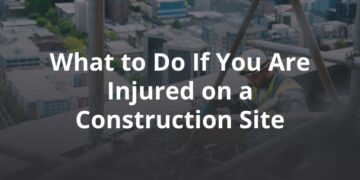Construction is the deadliest industry in the United States. Every year, more workers lose their lives in fatal construction accidents than in any other occupation. In an effort to prevent worker injuries and deaths, the Occupational Safety and Health Administration (OSHA) has safety rules, regulations and guidelines in place.
Unfortunately, employers do not always obey these rules. Many employers in the construction industry cut corners and violate OSHA regulations to save time or money.
If you or a loved one was injured while working in the construction industry, consult with an Austin construction accident injury lawyer in Texas about your legal rights and options. Your employer or another party could be financially responsible for your medical costs and losses.
Fall Protection
OSHA statistics state that “fall protection, construction” is the number one most commonly violated safety standard. Falls are the leading cause of construction worker deaths. 29 Code of Federal Regulations (CFR) 1926.501 sets forth a requirement for employers in the construction industry to provide fall protection systems.
This requirement makes it mandatory for employers to provide safe walking and working surfaces to prevent slip or trip and fall accidents. Any holes or skylights must be covered to prevent employees from falling. If workers have to work six feet or more above the ground, employers must provide guardrail systems, safety nets or personal fall arrest systems.
Rules for Ladders
Ladder falls are also a significant safety issue identified by OSHA. 29 CFR 1926.1053 lists specific requirements for all ladders used at construction sites:
- Ladders must be capable of properly supporting the required loads.
- Ladder rungs and steps must be level and uniformly spaced.
- Ladder rungs and steps should be treated to minimize slipping.
- Ladders should be inspected regularly for safety hazards.
- Ladder components should be surfaced in a way to prevent lacerations and punctures.
Ladder-related safety guidelines are the second-most frequently violated standard in the construction industry, according to OSHA.
Scaffolding Safety
Elevated worksites in construction require the use of scaffolding. OSHA has requirements in place for the safe and correct construction, use, maintenance and dismantling of scaffolding at a construction site. 29 CFR 1926.451 states the following:
- Each scaffold and scaffold component shall be capable of supporting, without failure, its own weight and at least four times the maximum intended load applied or transmitted to it.
- Each suspension rope used shall be capable of supporting, without failure, at least six times the maximum intended load applied or transmitted to it.
- Scaffolds shall be designed by a qualified person and shall be constructed and loaded in accordance with that design.
These are just three examples of dozens of safety rules and regulations that apply to scaffolding in construction. Violating any of these rules could lead to scaffolding collapses and deadly worker fall accidents.
Worker Training Requirements
OSHA sets forth general worker safety training and education requirements in 29 CFR 1926.21. This code states that all employers have a responsibility to instruct each employee on how to recognize and avoid unsafe conditions in the workplace.
Employers must also teach employees the regulations that apply to the specific work environment to control or eliminate potential hazards. These hazards may include working with toxic or flammable substances, harmful materials, or potentially dangerous plants or animals.
Eye and Face Protection
In the construction industry, special precautions must be taken to protect a worker’s eyes and face from potential hazards, such as contact with dangerous chemicals, gases or molten metal. Acceptable personal protective equipment depending on the type of work expected of the employee includes safety goggles, side protectors, face masks and face shields.
Preventive Maintenance and Inspections
OSHA has rules in place (29 CFR 1910 through 1910.1450) for the proper maintenance of tools, equipment and machinery used in construction. Tools that fall into a state of disrepair can be dangerous for workers. For example, a piece of heavy machinery that is missing its machine guard could lead to an amputation injury if a construction worker’s limb gets pulled into the machine.
A qualified maintenance and repair person must inspect equipment on a regular basis to verify its performance. If an issue is discovered, it must be remedied promptly to ensure correct safety compliance. Broken, faulty or malfunctioning pieces of construction equipment should be placed out of commission until repairs can be made or a replacement is installed.
Violated Safety Regulations Cause Construction Accidents
The four most common causes of construction worker deaths – known as the “Fatal Four” – are falls, struck-by objects or equipment, caught-in/between objects or equipment, and electrocutions. OSHA’s safety regulations and construction site guidelines are in place to help prevent these injury risks and related worker deaths. If every construction site manager or employer obeyed these rules, the Fatal Four could be prevented.
If an employer in construction falls short of the required safety standards and an employee suffers an injury as a result, the victim could have multiple legal options available for making a financial recovery. While workers’ compensation benefits may be available without proof of fault, evidence of negligence in the form of a violated regulation could enable the victim to file a personal injury claim against the employer.
A personal injury suit could result in greater financial compensation than workers’ compensation, such as damages for pain and suffering. Discuss your specific construction accident case with an attorney at FVF Law Firm to determine the right route for you.
When to Contact a Construction Accident Lawyer
OSHA rules play a critical role in ensuring the safety and well-being of workers in the construction industry. If one or more parties violates an OSHA construction site safety regulation and this results in a worker injury or death, the victim or victim’s family may be able to receive compensation for related losses, such as:
- Medical costs
- Lost income from being unable to work
- Pain and suffering (physical and emotional)
- Permanent disability
- Wrongful death
A financial recovery can help a construction accident victim move forward with greater peace of mind. If you suspect that a violated OSHA regulation played a role in your recent construction site accident in Texas, contact FVF Law Firm for a free, no-obligation case consultation. Our attorneys have over 100 years of combined experience. We can help you understand the complexities of your case and teach you how to protect your rights during this difficult time.





